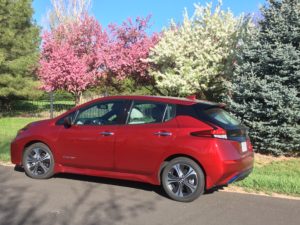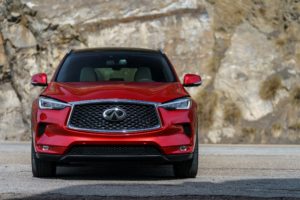
Two automobile power sources beyond the norm, one from Nissan and the other from Nissan’s luxury division Infiniti, have rolled my way.
Particularly smooth is the Nissan Leaf’s fully electric system, which for the second-generation 2018 model has achieved an extended range – to 152 miles. The Leaf was introduced seven years ago, and, according to Nissan, has sold more full electrics than any other make.

Adding interest was the arrival of a preproduction model of the 2019 Infiniti QX50 with its VC-T power; it is the first production vehicle whose internal-combustion engine will actively vary its compression ratio, from 8.0:1 to 14.0:1.
The VC-T stands for “variable compression turbocharged,” which develops 268 horsepower and 288 lb.-ft. of torque from the 2.0-liter, 4-cylinder engine. It is equipped with a continuously variable transmission.
Though it was scheduled for a week’s stay with me, the loaners of the Infiniti came by after only a day to retrieve the QX50 and its special engine. It apparently is needed for an Asian auto expedition; I thought I heard someone say, “to Mongolia.”
I drove it barely over 50 miles – to Fort Collins with Jan for dinner at an Olive Garden restaurant, before relinquishing the keys the next day. In so few miles, it was difficult to identify characteristics of the new engine, which varies fuel/air mixture in the cylinders depending on driving situations (highway or in-city) and throttle demands by the driver. Acceleration was strong when called upon, the steering was heavily assisted and the ride was exceptionally good.
The luxury compact Infiniti SUV is of front-wheel-drive configuration, with available all-wheel drive (formerly rear-drive and AWD). Premium fuel is recommended for the variable compression engine.
Key competitors, with their traditional engines, are Acura RDX, Audi Q5, BMW X3, Cadillac XT5, Jaguar F-Pace, Lexus RX, Mercedes GLC, Porsche Macan and Volvo XC60.
As for the new Nissan Leaf, it gained extended range through use of an improved 40-kilowatt-hour lithium-ion battery pack (up from 30 kWh) and 147-horsepower/236 lb.-ft. torque electric motor. It is surprisingly quick off the line.
The Leaf also introduces an E-Pedal feature allowing the driver to accelerate and brake with one pedal. If e-pedal is engaged, when throttle acceleration lessens or stops, regenerative braking takes over and slows the car at a rate dependent on the easement of the pedal. This is helpful driving in city traffic; the actual brake pedal is still in place, waiting to be mashed by driver when needed.
ProPilot Assist, which I’ve tested in other Nissan and Infiniti products, maintains lane guidance, cruise-distance control and forward-collision warning and emergency braking. The lane guidance kept the Leaf on course, much less aggressively than it did for a Nissan Rogue in December. Though it should reduce driver stress, the ProPilot system reminds drivers that it is “hands-on” in usage.
Nissan says recharging the Leaf’s battery pack takes 35 hours at 110 volts or 7.5 hours at 220 volts. With a third of its range still available, I recharged it to full range at 110 volts in my garage in 20 hours.
The front-drive Leaf is offered in three trim levels, beginning with the S at $29,900, upgraded to the SV at $32,490 and topped off with the SL, which I drove, at $36,200. The addition of the ProPilot Assist boosted sticker price on the review model to $38,510.